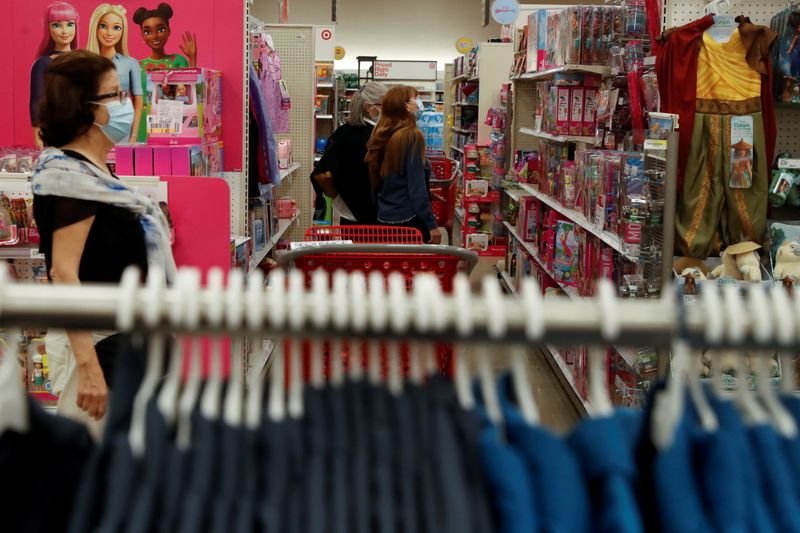By Lucia Mutikani
WASHINGTON (Reuters) - U.S. retail sales unexpectedly rose in September in part as more expensive motor vehicles boosted receipts at auto dealerships, but there are fears that supply constraints could disrupt the holiday shopping season amid continued shortages of goods.
Given the partial lift from inflation, the surprise increase in retail sales reported by the Commerce Department on Friday did little to change economists' expectations that consumer spending probably stalled in the third quarter. Inflation-adjusted sales, which rose moderately last month, are what is included in the calculation of gross domestic product.
"The solid retail sales report reflects both consumer resilience and escalating prices," said Sal Guatieri, a senior economist at BMO Capital Markets in Toronto. "The main concern now is that supply-chain disruptions and microchip shortages appear to be spreading, limiting selection and tamping down goods demand."
Retail sales rose 0.7% last month. Data for August was revised higher to show retail sales increasing 0.9% instead of 0.7% as previously reported. Economists polled by Reuters had forecast retail sales would slip 0.2%. Consumer prices increased 0.4% on a monthly basis in September suggesting the so-called real retail sales rose 0.3% last month.
An ongoing global shortage of microchips is forcing automakers to cut production, leading to a scarcity of inventory at showrooms, which is boosting prices. The semiconductor shortage has also impacted the supply of electronics and appliances. Congestion at ports because of a dearth of workers has also meant fewer goods on shelves heading into the holiday shopping season, limiting choice for buyers.
U.S. President Joe Biden on Wednesday announced that the Port of Los Angeles would join the Port of Long Beach, two of the country's busiest, in expanding round-the-clock operations to unload an estimated 500,000 containers on cargo ships offshore.
Spending shifted to goods from services over the course of the COVID-19 pandemic, straining supply chains. The rotation back to services, such as travel and dining out, has been slowed by a resurgence in coronavirus infections over the summer, driven by the Delta variant.
Retail sales are mostly made up of goods, with services, including healthcare, education and hotel accommodation, making up the remaining portion of consumer spending.
Economists expected consumers to start their holiday shopping early to avoid empty shelves, which would probably keep retail sales higher in October. Spending remains strong despite consumer sentiment shifting lower, thanks to strong household wealth and rising wages from a tightening labor market.
A survey from the University of Michigan on Friday showed consumer sentiment slipped further in early October because of the endless pandemic and the political wrangling in Washington over raising the federal government debt limit as well as more spending for infrastructure and social programs.
"Strength this month and next could be a result of well-telegraphed supply shortages leading consumers to begin holiday-season shopping earlier than usual," said Veronica Clark, an economist at Citigroup (NYSE:C) in New York. "This effect, as well as potentially binding supply limitations, could subsequently result in a drop in retail sales in November and December."
Retailers are cautiously optimistic that shortages will not derail the holiday season.
"We have seen record imports this year and are confident that collectively we can work through these challenges to ensure a healthy and happy holiday season," said Matthew Shay, president of the National Retail Federation in Washington.
Stocks on Wall Street were trading higher. The dollar dipped against a basket of currencies. U.S. Treasury prices fell.
Graphic: Congestion at Port of Los Angeles/Long Beach, https://graphics.reuters.com/USA-BIDEN/SUPPLY-CHAIN/lgvdwlngqpo/chart_eikon.jpg
AUTO RECEIPTS RISE
In September, sales at auto dealerships rose 0.5% after decreasing 3.3% in August. With unit sales declining, the increase in receipts reflected higher prices.
The average price of a new motor vehicle topped $45,000 for the first time ever in September, according to a report this week from Kelley Blue Book, a vehicle valuation and automotive research company in California.
Online retail sales rose 0.6%. Sales at clothing stores jumped 1.1%. More workers returned to offices after the Labor Day holiday and may have needed a new wardrobe after more than a year of working from home. Receipts at building material stores nudged up 0.1% and furniture outlets gained 0.2%.
Sales at service stations surged 1.8% because of higher gasoline prices. There was also an increase in receipts at sporting goods, hobby, musical instrument and book stores.
With coronavirus infections ebbing, the flow of traffic to restaurants and bars increased, lifting sales 0.3%. Restaurants and bars are the only services category in the retail sales report. Sales at electronics and appliance stores dropped 0.9%.
Excluding automobiles, gasoline, building materials and food services, retail sales rose 0.8% after increasing 2.6% in August. These so-called core retail sales correspond most closely with the consumer spending component of gross domestic product.
Economists believe consumer spending, which accounts for more than two-thirds of U.S. economic activity, was flat in the third quarter after a robust 12.0% annualized growth pace in the April-June period. Consumer spending growth estimates for the third quarter are mostly below a 2.0% rate.

That also suggests GDP growth braked sharply in the July-September quarter from the second-quarter's 6.7% pace. Growth estimates for the third quarter range from as low as a 1.3% rate to as high as a 4.0% pace. Some of the anticipated slowdown in growth reflects the fading stimulus from trillions of dollars in pandemic relief from the government.
"Inflation will take a major bite out of third-quarter real consumer spending growth," said Shannon Seery, an economist for Wells Fargo (NYSE:WFC) in Charlotte, North Carolina. "The main challenge for the fourth quarter will be finding everything on the shopping list as the supply chain crisis worsens."